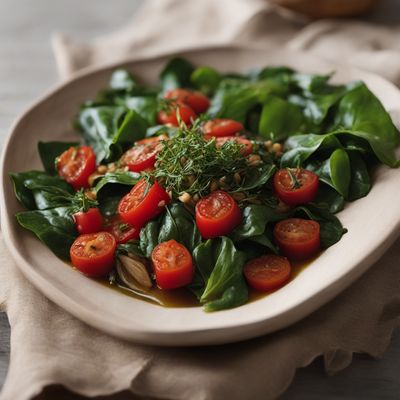
Ingredient
Swiss chards
Vibrant Greens: Exploring the Versatility of Swiss Chards
Swiss chards are characterized by their large, dark green leaves and colorful stems, which can range from white and yellow to pink and red. They have a slightly bitter taste when raw, but become milder and sweeter when cooked. The leaves have a tender yet sturdy texture, making them suitable for sautéing, steaming, or adding to soups and stews. Swiss chards are a versatile ingredient that adds both visual appeal and nutritional value to meals.
Origins and history
Swiss chards have a long history and are believed to have originated in the Mediterranean region. They have been cultivated for centuries and were highly regarded by the ancient Greeks and Romans for their medicinal properties. Swiss chards gained popularity in Europe during the Middle Ages and eventually made their way to the Americas with European settlers. Today, they are widely cultivated and enjoyed in various cuisines around the world.
Nutritional information
Swiss chards are low in calories and rich in vitamins A, C, and K. They also provide important minerals like magnesium and potassium. Incorporating Swiss chards into your diet can contribute to a well-rounded and nutrient-dense meal.
How to select
When selecting Swiss chards, look for bunches with vibrant, crisp leaves and firm stems. Avoid wilted or yellowing leaves, as they indicate age or poor quality. The stems should be colorful and free from blemishes. If possible, choose organic Swiss chards to minimize exposure to pesticides.
Storage recommendations
To prolong the freshness of Swiss chards, remove any rubber bands or ties and store them in a plastic bag or airtight container in the refrigerator. They can stay fresh for up to a week. If the leaves become wilted, you can revive them by soaking them in a bowl of ice water for a few minutes before using.
How to produce
Swiss chards can be easily grown in home gardens or containers. They thrive in cool weather and can be sown directly in the ground or started indoors and transplanted. Provide them with well-drained soil and regular watering to ensure healthy growth. Harvest the leaves when they reach the desired size, taking care not to remove all the leaves from a single plant to allow for continued growth.
Preparation tips
Swiss chards can be prepared in various ways. To sauté, heat olive oil or butter in a pan, add chopped garlic or onions, and cook until fragrant. Add the Swiss chard leaves and stems, season with salt and pepper, and cook until wilted. Swiss chards can also be steamed, blanched, or added to soups, stews, and stir-fries. The leaves can be used as a substitute for spinach in recipes, and the stems can be pickled or added to salads for added crunch.
Substitutions
Spinach, kale, or collard greens can be used as substitutes for Swiss chards in most recipes. However, keep in mind that the flavor and texture may vary slightly. Spinach is a good alternative for raw preparations, while kale or collard greens can be used in cooked dishes that require a heartier green.
Culinary uses
Swiss chards are incredibly versatile and can be used in a variety of culinary applications. They can be sautéed with garlic and olive oil as a simple side dish, added to omelets or quiches, or incorporated into pasta dishes and grain bowls. Swiss chards are also commonly used in Mediterranean and Middle Eastern cuisines, where they are featured in dishes like spanakopita, dolmas, and soups.
Availability
Swiss chards are widely available in grocery stores, supermarkets, and farmers markets, particularly during the spring and fall seasons. They are commonly found in North America, Europe, and other regions with temperate climates.
More ingredients from this category
Recipes using Swiss chards » Browse all

Slovenian-inspired Afang Soup
Savory Slovenian Greens Stew

Monégasque Barbagiuan
Savory Delights from Monaco: Monégasque Barbagiuan

Ticinese Bread Cake
Savory Delight: Ticinese Bread Cake with a Swiss Twist

Blitva i kopriva na padelu (Swiss Chard and Nettle on a Skillet)
Savory Greens Delight: Blitva i Kopriva na Padelu

Acelgas con Tomate (Swiss Chard with Tomato)
Savory Delight: Spanish Style Swiss Chard with Tomato

Croatian-style Gyoza
Delicious Croatian Dumplings: Gyoza with a Twist

Canestrello di Brugnato
Savory Delight: Canestrello di Brugnato - A Taste of Italian Tradition

California-style Swiss Chard Stew
Sunshine Greens: A Vibrant California Twist on Swiss Chard Stew

Bieta in Brodo with Parmesan Crisps
Savory Swiss Chard Soup with Crispy Parmesan

Coste al Sugo with a Twist
Savory Swiss Chard in Tomato Sauce

Ekwang à la Occitane
Savory Occitan Plantain and Palm Nut Stew

Kuwaiti-style Swiss Chard with Tomato
Savory Tomato-infused Swiss Chard: A Taste of Kuwaiti Delight
